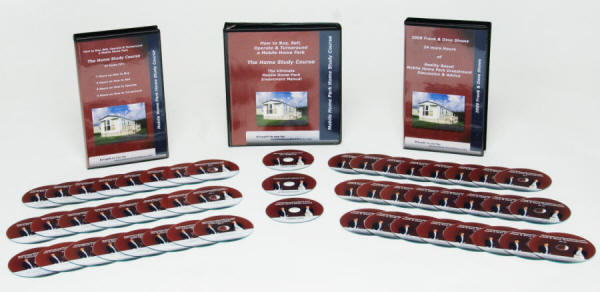We recently purchased a mobile home park in Arnold, Missouri that was, at one time, a premier property. When it was built around 1952, it was immaculate and the homes were new and the yards manicured. The residents had jobs and careers, and drove nice cars. The entry was attractive, and there were never any police calls or code violations. Today, while some of those tenants still remain (probably about half the park), the aesthetics are atrocious, and the city required us to post a bond just to get a clean bill of health for the loan. So how do you bring a park back from the brink of death, and make it a nice place to live and a good money maker? How do you perform mobile home park CPR?
Get everyone on the same page
The first step is to let the world know what the plan is --that you are reclaiming the park and making it the nicest place in town again! This will let the good tenants know to “hang in there, help is on the way” and the bad tenants know that “the days of wild partying, not paying rent, and living like scum is over.” It also lets the city know that “happiness is around the corner” and the neighbors know that “don’t worry, the problem is being fixed.” You can’t tell enough people – there is no downside, only upside to this public relations blitz. I’ve even given articles to the local newspaper about it in some towns.
Make the common areas set the example
You can’t expect people to fix up their property until the park itself take the lead on the reclamation. All the common areas – the parts the park owns and controls – should be mowed, edged, round-up sprayed, painted, free of any debris. If the roads need work, get it started. This type of behavior is infectious – the tenants will immediately respond by following your lead.
And don’t forget the entry
The first impression of a park is key. Your sign should be stellar. White vinyl fencing and some native plants (that don’t require irrigation) can make an ugly entry look like a country club. Make every resident, inspector, lender and appraiser think “wow, this park looks great” upon seeing your entry. And don’t forget to maybe put a banner out there talking about move-in specials or homes for sale.
Don’t let the homes fester, either
Does the park have park-owned homes that come with it? Then get the exteriors fixed up now (you can do the interiors later). Every home should have a minimum standard on the exterior of no broken windows or doors, no rotted siding, decent paint job with a decent color, and vinyl skirting (or something at least attractive). The lots should have all debris removed and the yards immaculate. Sure the floors may be missing inside – you can get that remodeled later.
Drop the bomb on the tenants about the new rules
Get every tenant a new lease and rules, and then go after the ones that don’t follow the rules. Be relentless. The goal is to get them in order or out of the park. If you lose some tenants over the “no big dog” or “no home without skirting” rules, then so be it. Once you kick out a couple of them, the rest will normally get the message. Remember that it only takes one nasty house and yard to ruin the lifestyle quality of the rest of the neighbors – plus it defeats your message of “cleaning up the park”. You control the park, not the tenants. If they won’t do what you want, then no-renew their lease and get them out.
Collections cures a lot of problems
When you look at the rent roll and the amounts owed, you immediately see a correlation between the nice tenants paying on time and the bad tenants with big balances. A great way to get rid of the tenants you don’t want is simply to demand that they pay or get evicted. We call this policy “no pay/no stay” and the attack plan is simple: you either pay the rent in full or you’re gone. No payment plans. No mercy. You’re out on the street. This policy will eradicate the problem tenants faster than non-renewing leases, and will weed out the tenants who really can’t afford to live there.
Continue to narrow your list
When you buy a park that needs CPR, you initially may have an action plan with 100 items that need to be fixed and addressed. Over time, this list will dwindle. Keep reviewing and marking off items, and focus on attacking what’s left. Don’t get a warm fuzzy feeling because you have half the list done, and that you can slow down. You must continue to the end. It’s a great feeling when you narrow the list down to the final “top 10”. But your job is not done until the list is at zero.
Renovate the homes and get good tenants in them
Nothing is worse for a park than vacant homes. It scares potential tenants, and it attracts drifters and vandals. Get the home renovated and sold as fast as you can. Of course, you can’t do them all at one time. But try and triage them so that you do the easiest ones first, and get them filled to get the rent going as well as humans in those trailers.
Don’t let it happen again
Once you turn around a mobile home park, the #1 goal should be to never let it get that way again. However, I have many times driven by parks that the owner got perfect, and then let them go down the drain again. It’s easy to do. How many people have undergone a diet – lost 10 pounds – and then gained it all back later. If you have lost the interest to keep the park up, then sell it before you let it go down again. There’s no excuse to let a park get run down. Make sure you have the controls in place to manage the manager, to monitor the drivers to profitability, and to see the park first-hand periodically.
Conclusion
CPR on a park is no different than CPR on a person. You have to move fast, and you have to proactively work the important issues first, and come back to the lesser later. Unlike saving a person, however, there are huge financial rewards to saving a park – and just about as big a sense of accomplishment. Sure, you won’t be able to say “I saved someone’s life”, but you will be able to say “I improved many people’s lives” – and that’s a great feeling.







